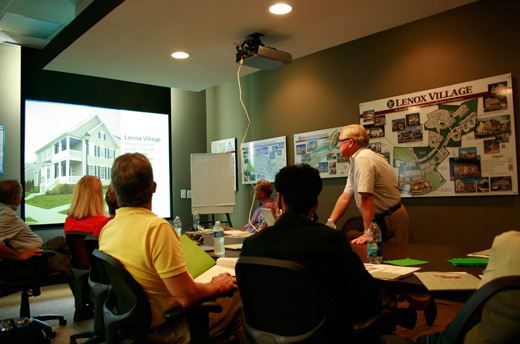
Last week, a local group of 16 traveled to Nashville, TN to tour new developments and see first-hand the successes experienced from using
form-based codes. The group included citizens, community council representatives, business leaders, and four Cincinnati City Council members - all interested in learning more about form based codes and how they can be implemented in Cincinnati.
Headed by
Vice Mayor Roxanne Qualls and council members Laure Quinlivan, Wendell Young and Charlie Winburn, the group toured three developments in and around Nashville, experiencing new development, infill, and revitalized areas of Nashville that capitalized on the basic idea behind form-based code: creating places where people want to be. The developments toured included:
- Lenox Village: Residential development that focuses on mixing different housing types and sprinkling in public spaces along with a retail sector within the development.
- The Hill Center: Redeveloped lifestyle center with office space above and retail below - anchored by a Whole Foods and a YMCA.
- The Gulch: Previously a deserted warehouse district, now a newly incorporated part of downtown Nashville's urban fabric, connecting residential with retail and nightlife.
These new developments were conceived through an intense charrette and community input process that included the standard visual preference surveys. The city of Nashville then teamed with the developers of these communities to create a detailed neighborhood design plan for each new undertaking that creates a standard for the neighborhood. Once the plan is approved, any new development or changes to the area is required to adhere to the zoning.
According to Qualls, form-based codes are used as a tool, regulating development to achieve a particular urban form. Utilizing this idea creates a specific urban realm by controlling the physical form of the neighborhood instead of its land use.
In communities designed with form-based codes public places give people, not automobiles, precedence. This is realized by implementing strategies such as streets with fewer car lanes and wider sidewalks, bringing buildings closer to the sidewalk, creating architecture at a human scale, and utilizing streetscaping and trees to create more enjoyable public space.
Early Cincinnati neighborhoods like Hyde Park, Mt. Lookout, Clifton and others were originally planned with inspiration from the
1916 New York Zoning Resolution which influenced neighborhoods around the country at that time. Qualls and other city leaders believe it is time for a new approach that fits 21st Century habits.
In addition to a different land planning technique, Qualls noted that many of Cincinnati's original neighborhoods were built along 600 miles of streetcar lines, creating linear neighborhood business districts like Westwood and Oakley.
What was old is new again, as developers are realizing the potential and profit behind developing both retail and residential spaces to a human scaleand bringing in form-based code elements that people inherently enjoy and appreciate.
Qualls, who primarily organized the
trips to Nashville, hopes that the trips will help educate other community leaders and her fellow council members on these ideas and methods. She hopes to move forward with new form-based codes in pilot neighborhoods throughout Cincinnati that have expressed interest in creating their own development plans in order to spur growth and bring neighborhoods back to the people.
The City will work with
Opticos Design on the development of new form-based codes throughout Cincinnati. If all goes according to plan, the necessary zoning code amendments could take place by fall 2010.
Writer:
Jenny KesslerPhotography by Jenny KesslerStay connected by following Jenny on Twitter
@JenLKessler
Enjoy this story?
Sign up for free solutions-based reporting in your inbox each week.